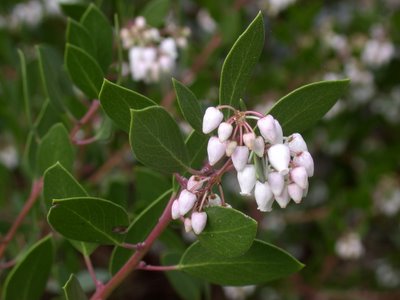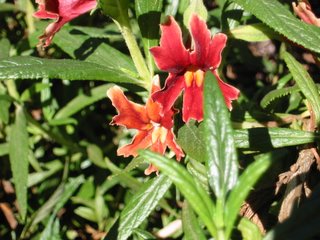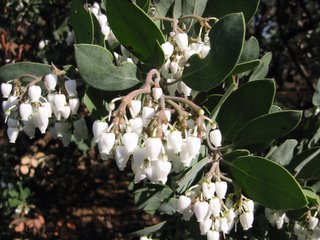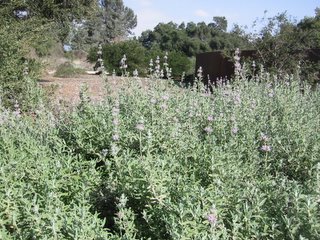
Photos of Arctostaphylos 'Howard McMinn' courtesy of Barbara Eisenstein
In considering what to write about this month, I decided to showcase a seasonally appropriate genus (group of plants) while keeping the theme of substitution in mind. Manzanitas went right to the top of my list. Now is a great time to consider these magnificent natives. There are plenty to choose from, given that California boasts more than 40 species plus numerous cultivars (varieties of plants selected and grown for particular features).
Bestowed with a Spanish common name for small apple-like fruits that appear in bunches a couple months from now, manzanitas (Arctostaphylos) are in glorious bloom this time of year. For about six weeks starting in January (and earlier for some species), dangling clusters of small, upside down urn/bell-shaped subtly scented flowers ranging in color from white to pink adorn curled red, purple or burgundy-colored branches.
A great place to experience this diverse group of evergreen California native plants is Rancho Santa Ana Botanic in Claremont. There you’ll see low-growing ground covers to large shrubs that reach about 20 feet high.
Manzanitas are happiest when planted in well-draining acidic soil that is low in nutrients, rocky and sandy being the most preferable. Definitely do not fertilize and always give new plants ample air circulation.
Manzanitas are versatile when it comes to sun exposure. The popular ‘Howard McMinn’ hybrid of Arctostaphylos densiflora takes full sun or part shade/sun and is an easy, garden-tolerant (accepts a fair amount of moisture but doesn’t want to sit in water) shrub that matures at about 5 to 7 feet high and 6 to 10 feet wide. Beaucoup blooms of dainty pale pink flowers and light green, upright leaves are lovely attributes of this variety.
Its edible fruit is a magnet for many animals and birds. Birds also appreciate the dense twisting branches for shelter; while butterflies, hummingbirds and honeybees are drawn to the flowers’ nectar.
Try ‘Howard McMinn,’ its cousin, ‘Harmony,’ and relative ‘Sentinel’ in place of non-native hedge plants such as Buxus (boxwood), Escallonia, Ligustrum (privet), and Rhaphiolepis.
Most Arctostaphylos species are highly drought tolerant once their root systems have been established. You can help them reach that stage by regular, careful watering (don’t overdo it) after planting. Avoid drip irrigation; it kills manzanitas and many other natives. Within a couple of years, you should be looking at minimal to no supplemental watering.
Wild manzanitas have dwindled significantly (some species are endangered or threatened), so I can’t recommend them highly enough for the home garden. They’re such a valuable plant to wildlife and the ecosystem.
Try the following two species native to Southern California in exchange for invasive exotics and non-natives consuming our landscapes and feel great restoring a bit of the original California.
‘Frazier Park’ big berry manzanita (Arctostaphylos glauca cultivar) takes full sun, has gray foliage and white flowers, grows to about 3 to 4 feet tall, sports red bark, does well in pots and in the ground, is deer tolerant and attractive to birds and butterflies.
‘Los Angeles’ big berry manzanita (A. glauca cultivar) is native to the Santa Monica Mountains. White flowers, light green leaves and smooth red bark grace this 4 to 12 foot tall plant. Birds and butterflies love it. Deer don’t care about it. It takes full sun or part shade.
For more information on manzanitas and other valuable natives, check out the
Las Pilitas website, the
Native Sons website and "California Native Plants for the Garden," the new book by California’s three premier horticulturalists – Carol Bornstein (of Santa Barbara Botanic Garden), David Fross (of Native Sons Nursery) and Bart O’Brien (of Rancho Santa Ana Botanic Garden). There are more resources than you may realize. Set aside some time and enjoy the search.











